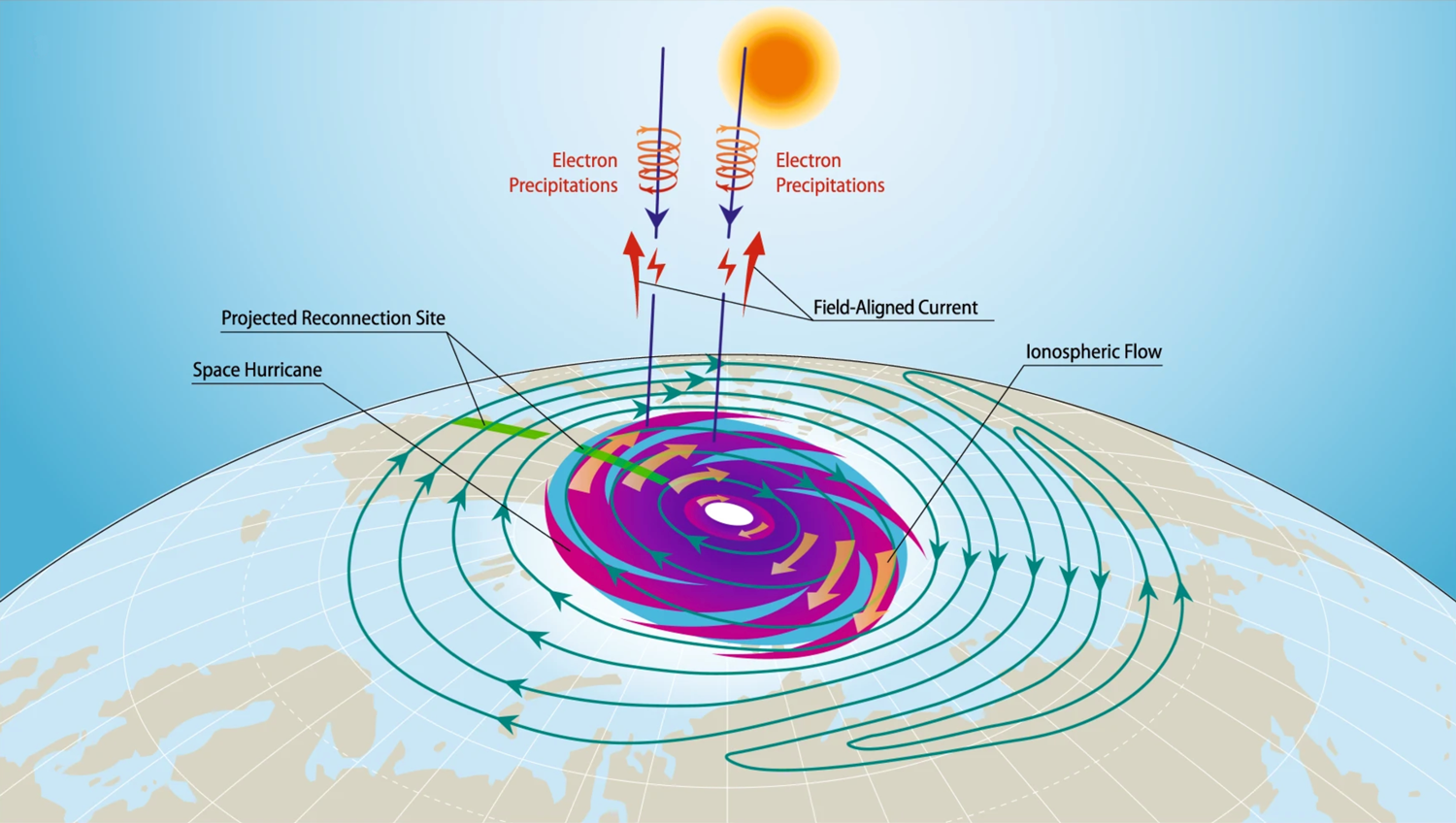The spectacular light displays of the polar aurorae are no great mystery. When solar wind hits Earth’s magnetosphere, electrons rain down into the upper atmosphere, which causes bursts of color across the sky in high-latitude belts around the planet. But aurorae over the north polar cap, especially during periods when the solar wind is quiet, have puzzled space weather experts for decades. Now an international team of researchers has found an explanation: space hurricanes.
In a recent paper published in Nature Communications, the team described an event that looked remarkably like lower atmosphere storms that slam into our coasts. On 20 August 2014, arms of plasma more than 965 kilometers (600 miles) across spun around a calm center, raining electrons into Earth’s upper atmosphere above the magnetic North Pole.
“I never conceived of the possibility that there would be a spiral-shaped, circular bright aurora in the middle of the polar cap.”
“The whole concept is surprising and exciting,” said Larry Lyons, a professor at the University of California, Los Angeles, and one of the study’s authors. “I never conceived of the possibility that there would be a spiral-shaped, circular bright aurora in the middle of the polar cap.”
Lead author Qing-He Zhang of Shandong University and his students spent 2 years combing through thousands of auroral images taken by the low-Earth-orbiting satellites of the U.S. Defense Meteorological Satellite Program. They found dozens of cases of what looked like space hurricanes in images collected over the past 15 years, but none so clear as the one that occurred in 2014 and lasted about 8 hours.
John Foster, a research scientist at the Massachusetts Institute of Technology’s Haystack Observatory who was not involved in the study, recalls spotting a similar phenomenon over the pole some 50 years ago, but experts couldn’t explain what they were seeing at the time. “In those days, the spacecraft, even though there were a lot of them up in space, they did not have the kind of instrumentation that you would need to really understand what was taking place,” he said. “What makes this event really special is the wide variety of instrumentation that was available in space to look at the characteristics of this phenomenon.”
Zhang’s team was able to combine a wealth of aurora, plasma, and magnetic field data from the space hurricane with a powerful, 3D simulation to reproduce the space hurricane using the solar wind and magnetic field conditions on that day in 2014.

A Tale of Two Types of Hurricanes
Foster cautions that it’s important to remember that although the space hurricane may look a lot like its tropospheric counterpart, the forces driving the two types of hurricanes are totally different.
Space hurricanes are also much less of a risk to humans than the more familiar variety, although “we do have some evidence that it did cause strong and unusual scintillations,” Zhang said. “These are fluctuations of radio waves passing through the ionosphere.” These disturbances could garble satellite communications or navigation. The storm may also heat up and expand the upper atmosphere, changing the density of the highly trafficked region; the change could cause drag and alter the orbit of any satellites or pieces of space debris that pass through it, according to Lyons.
“If you want to know where the space station is going to be a few hours from now, you have to know what kind of an atmosphere it’s going through,” Lyons explains.
For Zhang and his colleagues, the identification of the space hurricane is only the beginning.
“There are several open questions remaining,” he said. “What controls the rotation of space hurricanes? Are these space storms seasonal like their tropical counterparts, perhaps limited to the summer when the Earth’s magnetic dipole is tilted just the right way? And can space hurricanes be forecasted like weather events on Earth?”
—Kate Wheeling (@katewheeling), Science Writer
Citation:
Wheeling, K. (2021), A space hurricane spotted above the polar cap, Eos, 102, https://doi.org/10.1029/2021EO156976. Published on 09 April 2021.
Text © 2021. The authors. CC BY-NC-ND 3.0
Except where otherwise noted, images are subject to copyright. Any reuse without express permission from the copyright owner is prohibited.

